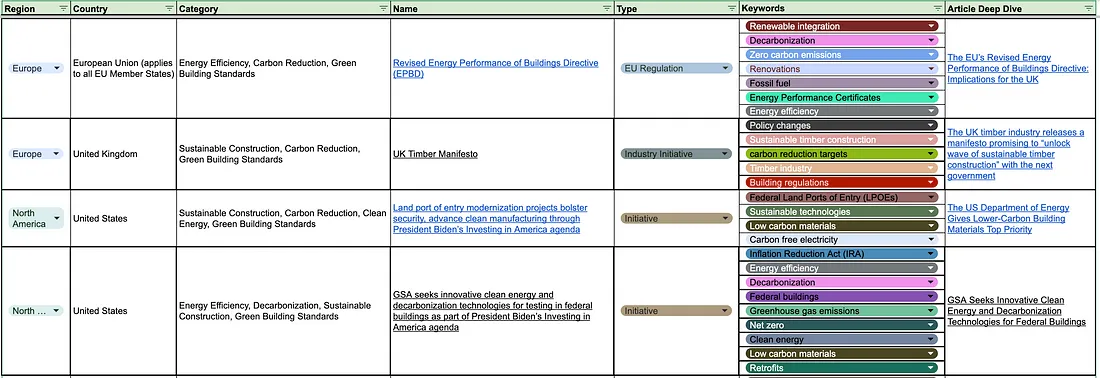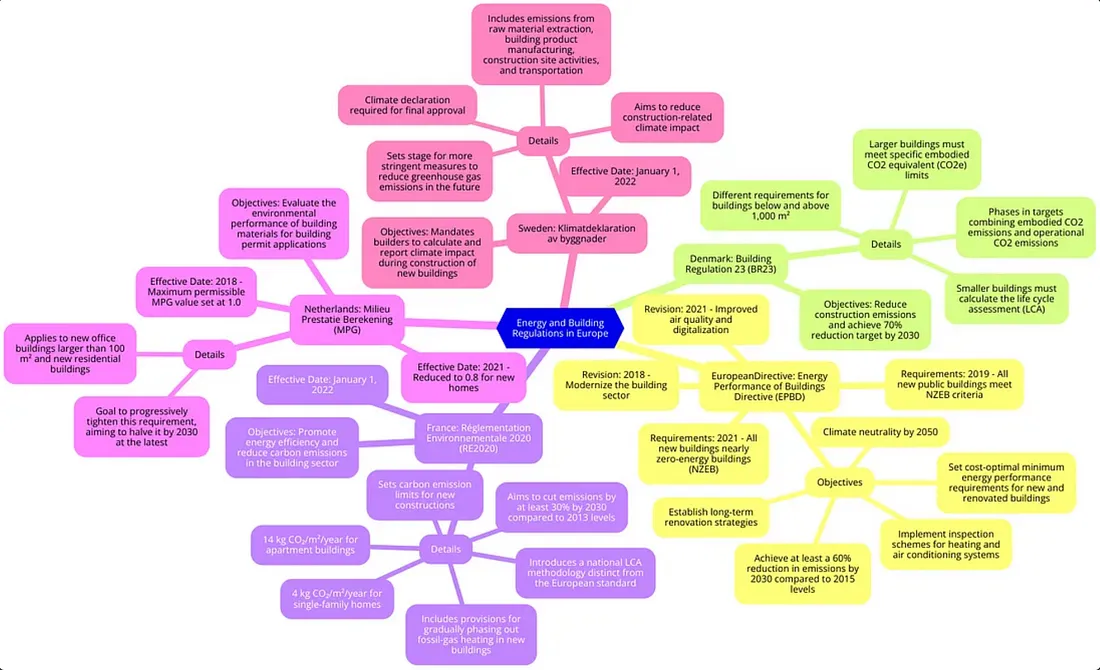- Kyoto Protocol
- Paris Agreement
- European Green Deal
- EU Taxonomy Sustainable Activities
- Energy Performance of Buildings Directive
- Building Regulation 23 (BR23)
- Réglementation Environnementale 2020 (RE2020)
- Milieu Prestatie Berekening (MPG)
- Klimatdeklaration av byggnader
- Buildings sector science-based target-setting criteria
- Zero Carbon Building Standard — Canada Green Building Council (CAGBC)
- Revised Energy Performance of Buildings Directive (EPBD)
- UK Timber Manifesto
- Land port of entry modernization projects bolster security, advance clean manufacturing through President Biden’s Investing in America agenda
- GSA seeks innovative clean energy and decarbonization technologies for testing in federal buildings as part of President Biden’s Investing in America agenda
- BREEAM certification from BRE
- Living Building Challenge
- The Net Zero Carbon Buildings Commitment
- Edge buildings
- Environmental Regulation 2020 — RE2020
- The Climate Declaration Act for New Buildings
- Bepalingsmethode Milieuprestatie
- FutureBuilt
- RICS Whole life carbon assessment (WLCA) for the built environment
- The London Plan
- Zero Carbon Building Standards
- LEED
- Local Law 97
- SE2050
- Green Star Australia
- State Environmental Planning Policy (Sustainable Buildings) 2022
- Whole-of-Life Embodied Carbon Emissions Reduction Framework
- Green Star NZ
- BCA Green Mark
Tracking Embodied Carbon Regulations in Construction (Updated Oct 2024)

This tracker is designed to map current embodied carbon regulations across various regions and countries, providing you with an overview of key facts and relevant supporting articles. We’re committed to keeping it up-to-date with the latest and emerging regulations, so be sure to check back regularly for the most recent updates in the world of sustainable building and environmental standards.
The Architecture, Engineering, and Construction (AEC) industry is undergoing a significant transformation as it increasingly embraces sustainability. Driven by environmental concerns, technological advancements, and shifting consumer expectations, sustainability is no longer a mere option but a necessity. Regulations are at the forefront of this change, compelling AEC professionals to integrate sustainable practices throughout the lifecycle of their projects. This article provides an overview of the latest news and regulatory updates in sustainability within the AEC industry, outlining what these changes mean for professionals and stakeholders involved.
Overview of Sustainability Regulations in the AEC Industry

Sustainability regulations in the AEC industry are designed to reduce the environmental impact of construction activities, promote energy efficiency, and ensure the use of sustainable materials. These regulations are often guided by global commitments such as the Paris Agreement, regional policies, and local building codes. The primary focus areas include reducing carbon emissions, minimizing waste, enhancing resource efficiency, and ensuring the health and well-being of building occupants.
For the AEC industry, these regulations mean a shift in how projects are designed, executed, and maintained. The industry must adopt new technologies, rethink traditional processes, and collaborate across disciplines to meet these stringent standards. Failure to comply with these regulations can result in penalties, project delays, and reputational damage, making it crucial for industry players to stay informed and adaptable.
Key Regulatory Updates and Their Implications
1. Carbon Reduction Mandates
Recent regulations have increasingly focused on carbon reduction in the built environment. Many regions are setting strict targets for carbon neutrality in new constructions and retrofits. For instance, the European Union’s Green Deal has set ambitious goals for decarbonizing the building sector by 2050. This means AEC professionals must prioritize low-carbon materials, energy-efficient designs, and renewable energy sources in their projects.
2. Circular Economy Initiatives
The concept of a circular economy, which emphasizes recycling, reuse, and reduction of waste, is gaining traction in the AEC industry. Regulations are pushing for materials and components to be designed for disassembly and reuse, promoting longevity and reducing the demand for new resources. This shift impacts material selection, construction methods, and waste management practices.
3. Energy Efficiency Standards
Governments are updating energy codes to require higher efficiency in building designs. The U.S., for example, has implemented the latest versions of ASHRAE and the International Energy Conservation Code (IECC), which set forth stringent energy performance requirements. For AEC professionals, this necessitates the integration of advanced energy modeling, high-performance building envelopes, and smart building technologies to achieve compliance.
4. Green Building Certifications
Certifications such as LEED (Leadership in Energy and Environmental Design), BREEAM (Building Research Establishment Environmental Assessment Method), WELL Building Standard and more continue to influence the market. Regulatory bodies increasingly recognize these certifications, incorporating them into public procurement processes and incentives. Achieving these certifications requires careful consideration of sustainability criteria throughout the project lifecycle, from design to operation.
5. Health and Well-being Regulations
The focus on indoor environmental quality, occupant health, and well-being is becoming more pronounced in sustainability regulations. Standards related to air quality, natural lighting, and acoustic performance are being tightened. These regulations are particularly important in the post-pandemic world, where the design of healthy, adaptable spaces is paramount.
Conclusion
The sustainability movement in the AEC industry is gaining momentum, driven by increasingly firm regulations aimed at reducing environmental impact and promoting healthier living spaces. Staying at the forefront of these regulatory updates is essential for AEC professionals who wish to remain competitive and deliver projects that meet the demands of the future. As the industry continues to evolve, those who embrace sustainability not just as a regulatory requirement but as a core value will be best positioned to lead the way in creating a resilient, sustainable built environment.
Sources
Related articles

Climate-Resilient Materials for the Built Environment: A Data-Centred Prime
As climate volatility intensifies, resilience metrics are fast becoming as critical as carbon data in material selection. This article outlines why adaptation is now a design imperative, how materials can be evaluated through a systems lens, and what KPIs project teams should demand. From self-healing concrete to fire-rated façades, we present a structured taxonomy of resilient materials, explain how to embed this intelligence into digital design workflows, and propose next steps for specification, benchmarking, and procurement.
Read more
The Most Interesting Low Carbon Products in Office Design
In this article and collection, we highlight 11 outstanding products that contribute to a lower carbon footprint in office design.
Read more
Top Low Carbon Building Boards: Performance, Benefits, and Use Cases
The building boards highlighted in this article and collection showcase low-carbon innovation in modern construction.
Read more